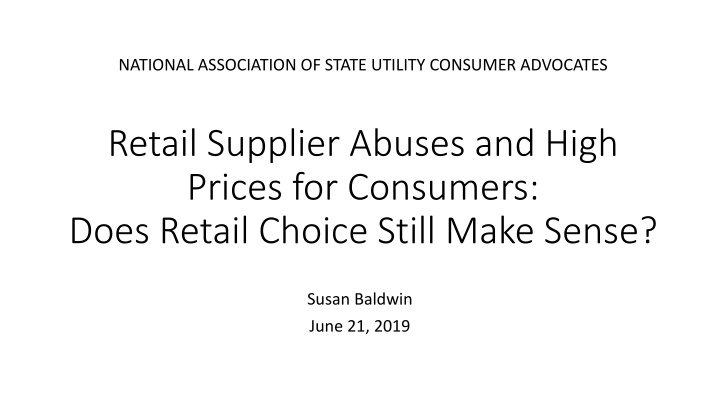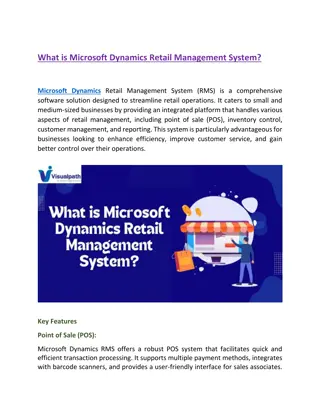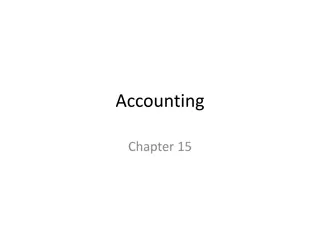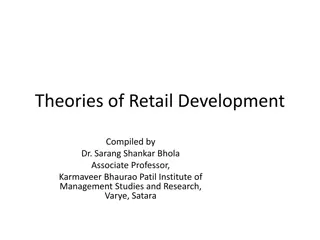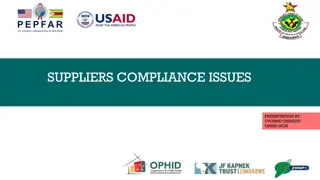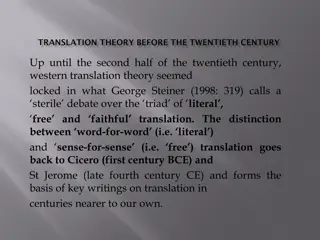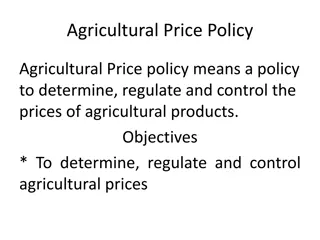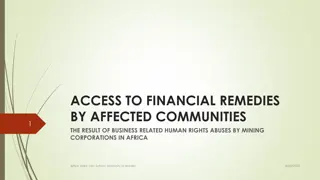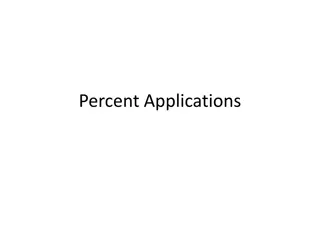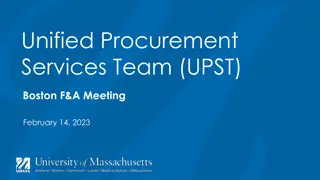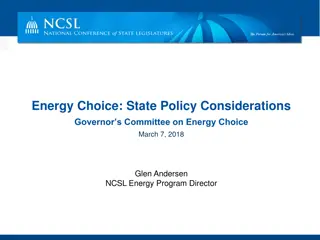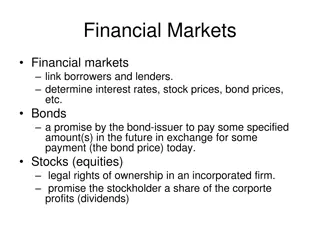Retail Supplier Abuses and High Prices: Does Retail Choice Make Sense?
This content discusses the impact of retail choice on consumers, particularly regarding high prices and abuses by retail suppliers. Case studies from Maryland, Massachusetts, and Connecticut highlight the challenges faced by residential customers. The findings raise questions about the effectiveness of retail choice in the energy market.
Download Presentation

Please find below an Image/Link to download the presentation.
The content on the website is provided AS IS for your information and personal use only. It may not be sold, licensed, or shared on other websites without obtaining consent from the author.If you encounter any issues during the download, it is possible that the publisher has removed the file from their server.
You are allowed to download the files provided on this website for personal or commercial use, subject to the condition that they are used lawfully. All files are the property of their respective owners.
The content on the website is provided AS IS for your information and personal use only. It may not be sold, licensed, or shared on other websites without obtaining consent from the author.
E N D
Presentation Transcript
NATIONAL ASSOCIATION OF STATE UTILITY CONSUMER ADVOCATES Retail Supplier Abuses and High Prices for Consumers: Does Retail Choice Still Make Sense? Susan Baldwin June 21, 2019
Topics Introduction Harm to all residential customers (purchasing individually) Disproportionate harm to disadvantaged customers Conclusion Views expressed are my own! June 21, 2019 Susan Baldwin | NASUCA Mid-Year Meeting 2
Estimates of participation and loss from residential studies PARTICIPATION NET LOSS STUDY PERIOD $200 million $7.2 million (hardship) 2015 2018 2016 2018 Connecticut 25% to 35% Illinois 18% $551 million 2015 2018 Maine 16% $78 million 2014 2016 20% (electric) 18% (gas) $21 million (electric) $34 million (gas) Maryland 2018 18% (non-low-income) 36% (low-income) Massachusetts $253 million 2015 2018 20% (electric) 25% (gas) New York $1.2 billion 2014 2016 49% (low-income, PPL Electric region) FirstEnergy region $3 million $18 million 34-month period 58-month period Pennsylvania Rhode Island Not available $28 million 2014 2018 June 21, 2019 Susan Baldwin | NASUCA Mid-Year Meeting 3
Case Study: Maryland Where Do We Go From Here? report for Office of People s Counsel OPC has long history of advocating for consumer protection and initiating investigations of suppliers Estimated net consumer loss (electric and gas) of $54.9 million/year based on OPC-compiled, supplier-reported electric and gas rates PSC-reported participation rates Highlights need for Data on prices actually paid by consumers Understanding of impact on low-income customers and low-income communities Maryland s Dysfunctional Residential Third-Party Energy Supply Market (Abell Foundation) 40 low-income account holders interviewed for the report paid, on average, 51 percent more for electricity and 78 percent more for natural gas (versus BGE Standard Offer Service rates) June 21, 2019 Susan Baldwin | NASUCA Mid-Year Meeting 4
Case studies: MA and CT (actual prices paid) Massachusetts, 2016 2017 2018 Report prepared for the Massachusetts Attorney General s Office (See also Competing to Overcharge Consumers by NCLC) The AGO s analysis of data for July 2017 June 2018 will be produced in a forthcoming supplemental report Connecticut, 2016 2018 Analysis conducted on behalf of the Connecticut Office of Consumer Counsel Areas of focus: Overall participation rates, and losses from participation Differences in participation by consumer race and income June 21, 2019 Susan Baldwin | NASUCA Mid-Year Meeting 5
Frequency of varying levels of consumer loss: all incomes (MA) June 21, 2019 Susan Baldwin | NASUCA Mid-Year Meeting 6
Zip-level income and retail choice Selected MA cities, June 2017 June 21, 2019 Susan Baldwin | NASUCA Mid-Year Meeting 7
Participation: non-low-income June 21, 2019 Susan Baldwin | NASUCA Mid-Year Meeting 8
Participation: low-income June 21, 2019 Susan Baldwin | NASUCA Mid-Year Meeting 9
Participation rates by zip-level demographics (MA) NON-LOW-INCOME LOW-INCOME Entire state 18% 36% Majority-minority 27% 45% Limited English proficiency 25% 45% Lowest 20: median income 25% 44% Highest 20: median income 15% 18% June 21, 2019 Susan Baldwin | NASUCA Mid-Year Meeting 10
Retail choice harms disadvantaged customers (CT) Statewide Hardship customers pay premium of $0.017 per kWh $11.93 per month based on actual average usage Non-hardship customers pay premium of $0.010 per kWh $7.04 per month based on actual average usage Hardship participation is 35% Non-hardship participation is 27% June 21, 2019 Susan Baldwin | NASUCA Mid-Year Meeting 11
Retail choice harms communities of color (CT) In ten neighborhoods (ZCTAs) with highest percent minority: Percent minority ranges between 47% and 89% Hardship participation: 26 48% Average hardship premium: $0.017 0.026 per kWh Average non-hardship premium: $0.011 0.020 per kWh In ten neighborhoods with highest percent lacking English proficiency: Percent lacking English proficiency ranges between 15% and 27% Hardship participation: 28% 50% Average hardship premium: $0.017 $0.022 per kWh Average non-hardship premium: $0.010 $0.020 per kWh June 21, 2019 Susan Baldwin | NASUCA Mid-Year Meeting 12
Hardship customers fare better in wealthy communities than in poor communities (CT) Stark differences by neighborhood (ZCTA) median income Poorest: Waterbury, median income $12,036 Hardship participation rate of 50% Non-hardship participation of 44% Hardship premium is $0.021 per kWh Non-hardship premium is $0.010 per kWh Wealthiest: Wilton-Weston, median income $219,860 Hardship participation rate of 32% Non-hardship participation of 30% Hardship premium is $0.002 per kWh Non-hardship premium is $0.008 per kWh June 21, 2019 Susan Baldwin | NASUCA Mid-Year Meeting 13
Susan M. Baldwin smbaldwinconsulting@gmail.com www.smbaldwinconsulting.com (617) 388-4068 Conclusion Ms. Baldwin s views today are based in part on her participation in the following projects: Connecticut Public Utilities Regulatory Authority Docket No. 13-07-18, PURA Establishment of Rules for Electric Suppliers and EDCs Concerning Operations and Marketing in the Electric Retail Market, testimony and supplemental testimony (with Helen E. Golding) on behalf of the Connecticut Office of Consumer Counsel, March 10, 2014 and March 17, 2014 Are Consumers Benefiting from Competition? An Analysis of the Individual Residential Electric Supply Market in Massachusetts (with Sarah M. Bosley), prepared for the Massachusetts Attorney General s Office, March 29, 2018 Maryland s Residential Electric and Gas Supply Markets: Where Do We Go from Here? (with Sarah M. Bosley), prepared for the Maryland Office of People s Counsel, November 2018. Connecticut Public Utilities Regulatory Authority Docket No. 18-06-02, Review of Feasibility, Costs, and Benefits of Placing Certain Customers on Standard Service Pursuant to Conn. Gen. Stat. 16-245o(m), testimony on behalf of Connecticut Office of Consumer Counsel, February 27, 2019 Residential energy supply market: Unmet promises and needed reforms (co-authored with Frank A. Felder), The Electricity Journal, 32 (2019) 31 38 June 21, 2019 Susan Baldwin | NASUCA Mid-Year Meeting 14
